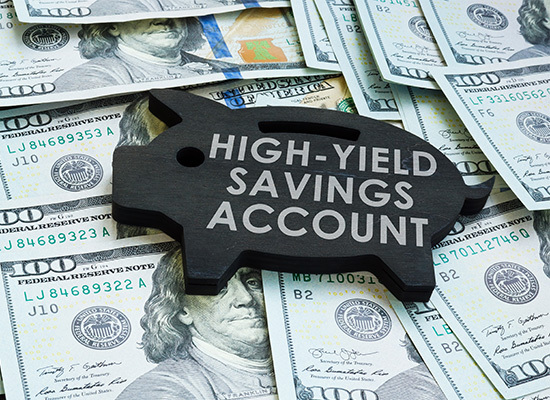 Contact
About Us
Articles
Home
Contact
About Us
Articles
Home

High interest rates can be a double-edged sword. They present both challenges and opportunities. Borrowers, unfortunately, may find it more expensive to take out loans for homes, cars, college or other purposes. On the bright side, savers can view high interest rates as an opportunity to earn better returns on their money. Let’s look at some strategies using high-yield savings accounts, certificates of deposit and money market accounts to take advantage of a high interest rate environment.
In an environment of high interest rates, savers can find a silver lining by taking advantage of high-yield savings accounts. Unlike regular savings accounts, high-yield savings accounts offer significantly higher interest rates, allowing you to grow your money more rapidly.
High-yield savings accounts are typically offered by online banks, though some traditional banks offer competitive rates as well. The advantage of an online bank is lower overhead costs, which enable them to offer higher interest rates to their customers. These accounts are usually FDIC-insured up to $250,000, making them a safe place to stash your cash.

Let's say the Federal Reserve has increased interest rates to combat inflation, resulting in savings account rates at traditional banks being around 2%. In such a scenario, high-yield savings accounts might offer rates as high as 3% to 4%.
Imagine you're saving for a down payment on a house, and you have $50,000 saved up. Placing this sum in a traditional savings account at 2% would yield $1,000 in interest over a year. On the other hand, a high-yield savings account at 4% would yield $2,000. That's double the amount — enough to cover inspection fees or moving expenses, for instance.
Or, let’s say you aim to have an emergency fund equivalent to six months of living expenses, amounting to $18,000. In a high-yield savings account offering a 3.5% interest rate, you could earn $630 over a year, compared to only $360 in a traditional account at 2%. In three years, the high-yield account would generate close to $2,000 in interest, effectively covering an unexpected medical bill or auto repair.
There are some factors to consider, such as minimum balance requirements for high-yield accounts. Some high-yield savings accounts require a minimum balance to earn the advertised interest rate.
Withdrawal limits may be another consideration. Federal regulations often limit the number of withdrawals you can make from a savings account each month.
Also, check if there are any maintenance fees, withdrawal fees or other charges that could eat into your earnings. At the same time, look for accounts that compound interest daily rather than monthly or annually, as this will result in higher overall returns.
Keep in mind that interest rates on high-yield savings accounts are variable and can change. While high rates are great, be prepared for the possibility of rates dropping in the future.
One strategy to maximize returns on a savings account is by utilizing a ladder strategy.
In the financial world, "laddering" is often associated with certificates of deposit (CDs), but the principle can also be applied creatively to high-yield savings accounts, particularly when interest rates are high or fluctuating. The ladder strategy is a nuanced approach that can help you maximize returns on high-yield savings accounts. While it may require more active management, the potential for increased earnings can make the effort worthwhile. If you're looking to get the most out of your high-yield savings accounts, laddering could offer the optimized balance of risk and reward you're seeking.
Unlike CDs, high-yield savings accounts do not have fixed terms. However, they do frequently have variable interest rates. The ladder strategy can be adapted here by distributing your savings across multiple high-yield savings accounts that offer different interest rates. This is particularly useful if:
For example, your savings can be diversified across multiple banks. Let's assume you have $20,000 to save. Instead of putting it in a single high-yield savings account, you could distribute it like this:
This strategy aims to optimize your returns and spread risk. While Bank C has the highest rate, it's promotional and will likely drop after six months. Bank A offers a high rate but is unpredictable, and Bank B offers a lower but stable rate.
This provides several advantages. You have the flexibility to move your money when the promotional rates end or if the rates drop significantly in one of your accounts. By capitalizing on higher promotional rates, even for a short period, you can boost your overall returns. And, if one bank lowers its interest rates, you won't suffer as much since your savings are spread across multiple banks.
Of course, there are some disadvantages, too. Managing multiple accounts can be cumbersome. Each account may have its own set of rules, including minimum balance requirements that you must be aware of.
Regular monitoring also should be part of your strategy. Keep an eye on the interest rates for all your accounts and be prepared to move your money if better opportunities arise.
High-yield savings accounts offer a lucrative option for savers in times of high interest rates. While they come with considerations like minimum balances and withdrawal limits, the significantly higher interest rates make them a compelling choice for anyone looking to get the most bang for their buck. With prudent planning, you can use these accounts to realize short-term goals more quickly, build a robust emergency fund, or simply grow your nest egg more efficiently.
When interest rates are high, savers have an opportunity to make their money work harder for them. One of the most reliable and straightforward financial instruments to accomplish this is a certificate of deposit (CD). Unlike a regular savings account, CDs offer fixed interest rates over a specified term, often providing higher returns. During periods of high interest rates, locking your money in a long-term CD can provide a guaranteed return that outpaces inflation.
A CD is a type of time deposit offered by banks and credit unions. When you open a CD, you agree not to withdraw your money for a certain period, usually ranging from a few months to several years. In return, the bank pays you interest at a rate that is usually higher than that of a regular savings account. CDs are a secure form of investment because they are FDIC-insured up to $250,000.

In a high interest rate environment, banks tend to offer CDs with significantly higher rates. Locking in a high rate in a long-term CD can be an effective strategy, especially for saving for retirement, as it guarantees a high return for the duration of the term.
For example, let's say you are 50 years old and want to set aside $50,000 toward your retirement. You choose a five-year CD offering a 4% annual interest rate. At the end of the term, your $50,000 would have grown to approximately $60,487, assuming the interest is compounded annually. If you had placed this money in a regular savings account with a 2% interest rate, you'd only have about $55,204 at the end of five years.
Or, suppose you are planning to buy a house in three years and have $30,000 for the down payment. You can lock this amount in a three-year CD offering a 3.5% interest rate. At the end of the term, you'll have approximately $33,597. If you kept that in a high-yield savings account at a 2% interest rate, you would have roughly $31,812.
There are some factors to keep in mind. CDs often come with early withdrawal penalties, which could eat into your earnings if you need to access your money before the term ends. Also, in a high interest rate environment, inflation is often a concern. While CDs offer higher rates, make sure that the interest you earn outpaces inflation to ensure real growth in your capital.
Some banks offer "callable CDs," which they can "call" back before the term expires if interest rates drop. Read the terms carefully to make sure you know what you're getting into.
Money market accounts are interest-bearing accounts offered by financial institutions, including banks and credit unions. They often require higher minimum balances compared to regular savings accounts but, in return, offer higher interest rates. Money market accounts also offer limited check-writing capabilities and may come with a debit card, which makes them more flexible than other savings options like CDs.
In a high interest rate environment, financial institutions are more likely to offer higher rates on money market accounts to attract deposits. These accounts become especially lucrative because they offer better returns without sacrificing liquidity.
For investors, high interest rates can provide other areas of opportunity.
For example, in a high interest rate environment, newly issued bonds will generally offer higher yields. Just be cautious about investing in long-term bonds, as their value can decline if interest rates go even higher.
Companies with solid fundamentals and a history of paying out dividends can be a good investment when interest rates are high. They offer both the potential for stock price appreciation and dividend income.
Meanwhile, real estate investment trusts (REITs) can be attractive during periods of high interest rates, especially those that focus on sectors less sensitive to interest rate fluctuations like health care facilities or certain commercial properties.
For homeowners and borrowers, one strategy is to refinance before rates go higher. For example, if you have existing loans at variable rates, consider refinancing to fixed-rate loans before rates climb any further.
However, if you must borrow, opt for shorter-term loans. These loans are less sensitive to interest rate fluctuations, which makes them a better choice when rates are high.
Navigating a high interest rate environment requires a savvy approach, especially when it comes to maximizing savings. While high-yield savings accounts offer flexibility and better returns, certificates of deposit provide the assurance of fixed rates for a predetermined period. Money market accounts offer yet another avenue for attractive gains while providing some degree of liquidity. Beyond traditional banking products, investment opportunities also emerge in the form of bonds, dividend-paying stocks and real estate investment trusts. A key to thriving in such an environment is to diversify your portfolio, understand your financial objectives, and keep a vigilant eye on market conditions. Armed with the right knowledge and strategies, you can turn a challenging financial climate into an opportunity for substantial growth.
Alliance America is an insurance and financial services company dedicated to the art of personal financial planning. Our financial professionals can assist you in maximizing your retirement resources and achieving your future goals. We have access to an array of products and services, all focused on helping you enjoy the retirement lifestyle you want and deserve. You can request a no-cost, no-obligation consultation by calling (833) 219-6884 today.


